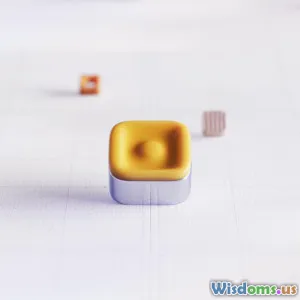
Future Trends in Graphic Design
8 min read Explore upcoming graphic design trends shaping the industry with tech innovations, AI, and creative shifts. (0 Reviews)
Future Trends in Graphic Design
Graphic design is an ever-evolving field that blends creativity with technology, shaping how we visually communicate ideas and stories. As the world becomes increasingly digitized and visually driven, graphic design must adapt and innovate at a rapid pace. What lies ahead holds fascinating possibilities—from AI-driven creativity to immersive experiences and sustainable aesthetics. This article explores the most significant future trends set to redefine graphic design, equipping designers, marketers, and creatives with insights to navigate the exciting road forward.
Introduction: The Pulse of Creativity Meets Innovation
Imagine a world where machines collaborate with human designers to develop unique artwork, where virtual realities provide interactive visual branding, and sustainable design guides ethical choices that impact the planet positively. Graphic design is no longer confined to 2D images on paper or screens; it's expanding toward a multi-dimensional, tech-infused domain that creates experiences, not just visuals. Staying informed on these emerging trends is essential in maintaining relevance and unleashing fresh creative potential.
The Rise of Artificial Intelligence in Design
Artificial intelligence (AI) is revolutionizing how designers work, offering powerful tools that enhance productivity and creativity.
AI-Assisted Creativity and Automation
Platforms like Adobe Sensei and Canva’s AI-powered tools enable designers to automate repetitive tasks such as resizing assets, color matching, and layout suggestions. More profoundly, AI generative models like OpenAI’s DALL·E and Midjourney help create original visuals based on textual prompts.
For example, fashion brand Gucci used AI-driven generative design to create digital patterns, demonstrating how AI can inspire and accelerate concept development. While concerns about loss of the 'human touch' exist, the consensus among industry leaders such as Aaron Koblin, former director of Google's Data Arts Team, is that AI serves as a creative partner rather than a replacement.
AI Ethics and Authenticity
As AI becomes a prevalent creative tool, ethical considerations in design are emerging. Authenticity and transparency about AI’s role in the creation process will become crucial for building trust with audiences.
Immersive Experiences: AR, VR, and 3D Design
Graphic design is no longer static but increasingly experiential.
Augmented Reality (AR) for Branding and Engagement
AR enables users to interact with digital elements overlaid in the real world. Brands like IKEA use AR apps that allow customers to virtually place furniture in their homes before buying, seamlessly blending design and utility.
Virtual Reality (VR) and Spatial Design
In VR environments, graphic design extends to spatial layouts, guiding users through digital spaces. Designing these immersive experiences demands new skills involving 3D modeling, spatial awareness, and UX design. Agencies such as Framestore are pioneering immersive branding campaigns, turning graphic design “inside-out.”
The Growth of 3D Design Elements
The re-emergence of 3D in graphic design provides depth, realism, and dynamic possibilities. Tools like Blender and Cinema 4D help create ultra-realistic visuals integrated into 2D media such as websites and advertisements.
Sustainability as a Core Design Principle
Environmental consciousness is no longer optional; it’s integral.
Eco-Friendly Visuals and Materials
Designers are adopting eco-friendly materials for print and packaging and using digital strategies to reduce waste. The shift to sustainable design aligns visual storytelling with a brand’s ethical stance, resonating strongly with eco-aware consumers.
Minimalism and Mindful Aesthetics
Minimalistic design, emphasizing fewer resources and cleaner aesthetics, is trending. Notable for lowering energy consumption on screens and print, this approach embodies the mantra ‘less is more’ in practical and philosophical senses.
Example: Patagonia’s commitment to environmental causes influences its straightforward, nature-focused visual identity that inspires trust and loyalty.
Personalization and Data-Driven Design
As data analytics become sophisticated, graphic design increasingly leverages user data for customized experiences.
Personalized web and social media graphics optimize user engagement by adjusting visuals based on behavior and preferences. Netflix’s evolving thumbnails and Spotify’s dynamic playlist covers exemplify how tailored visuals improve connection and conversion.
Harnessing data effectively requires designers to collaborate closely with data scientists, balancing creativity, privacy concerns, and usability.
Retro-Futurism and Nostalgia
Interestingly, the future of graphic design also looks back. Retro-futurism—design that imagines the future from a past perspective—is gaining momentum.
This style uses neon colors, pixel art, vaporwave, and synthwave aesthetics to evoke nostalgia while feeling fresh and futuristic. Brands harness this trend to appeal to millennial and Gen Z audiences who appreciate vintage vibes combined with modern digital culture.
Artists like Beeple integrate futuristic narratives with nostalgic visuals, further popularizing this exciting genre.
Conclusion: Embracing a Multifaceted Future
Graphic design in the future is a sophisticated fusion of technology, ethics, and emotional resonance. From AI and immersive technologies to sustainability and personalized storytelling, designers must embrace continuous learning and flexibility. This landscape inspires creative professionals to become not only visual experts but strategic innovators.
Whether you're a seasoned designer or an aspiring creative, understanding and adapting to these impactful trends will ensure your work remains relevant, influential, and transformative.
Actionable Takeaway: Start experimenting with AI tools, explore immersive media, and consider sustainability as a non-negotiable design constraint in your upcoming projects.
References & Further Reading:
- "How AI is Transforming Graphic Design" — Adobe Blog
- IKEA AR app usage statistics (Statista, 2023)
- "Sustainable Graphic Design Practices" — AIGA Eye on Design
- Emerging Trends in 3D Design — Blender Foundation Reports
With design trends evolving more quickly than ever, staying curious and proactive is the key to creative success.
Rate the Post
User Reviews
Popular Posts





















